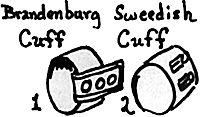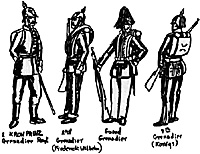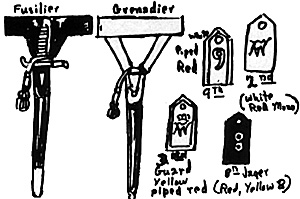(The following is reprinted from "The Armchair General" by the kind permission of the Editor.)
The Infantry of Prussia and of the later German Empire wore a dark blue single breasted tunic with red piping down the front and on the back tails. The trousers were of dark gray cloth, usually with a thin red stripe, and over which certain regiments wore white coveralls, most often the grenadiers, according to illustrations. For identification, numerous distinctions were maintained.
Cuffs: The Brandenburg Cuff was worn by most regiments (see figure 1.) The cuff was normally red, the patch red with three yellow metal buttons. An exception to this is the patch of the 1st, 2nd, 3rd and 4th Guard Grenadier Regiments, which was blue, while the 117th Line, for some obscure reason, had a cuff patch matching the shoulder tabs.
 The Swedish Cuff (figure 2) was worn by the four Gard zu Fus (Foot Guards) Regiments, the Guard Fusiliers and the 100th, 101st, 109th, 123rd and all Saxon Regiments. Of these regiments, all units except the Saxons had two white vertical bars with buttons at the top.
The Swedish Cuff (figure 2) was worn by the four Gard zu Fus (Foot Guards) Regiments, the Guard Fusiliers and the 100th, 101st, 109th, 123rd and all Saxon Regiments. Of these regiments, all units except the Saxons had two white vertical bars with buttons at the top.
Buttons: These were of yellow metal except for the 1st Gard zu Fus, The Guard Fusiliers, and the 1st and 3rd Battallions of the 89th (Grenadier), 40th (Fusilier), 115th, 116th, 117th, and 118th Infantry Regiments, which had white metal. Buttons at the top of the skirts in back of the tunic were shaped like hooks to carry the belt.
Collar: Scarlet. The following regiments having two bars of white lutzen (lace:)
- All regiments of the Prussian Guard,
1st and 3rd Battallions of the 89th Grenadiers (the 2nd Battallion had yellow lutzen.)
100th, 101st, 109th, 115th, 119th, 123rd Infantry.
Shoulder Straps: These varied according to army corps. Since the assignments of regiments to different corps varied somewhat, and the army went from one Guard and eight Line corps in 1866 to one Guard and twelve line in 1886, this may lead to some confusion, especially as the regiments of the lesser states, when addes to the Empire were assigned high numbers, which were sometimes matched to their old state regimental numbers (e.g. Regiment number such and such, 1st Mecklinburg, etc.) However, for the help it may provide, we are including the corps patch and regimental assignments in this article as of 1886.
Corps
The Corps assignments of the various German units determined their shoulder strap colors. In 1866 there had been only 8 Line Corps. By 1886, there were a total of 12.
| Corps | Infantry Regiments | Strap | Piping |
|---|---|---|---|
| I | 1, 3, 5, 33, 41, 44, 45 | White | White |
| II | 2, 9, 14, 21, 34, 42, 49, 54, 61 | White | None |
| III | 8, 12, 20, 24, 35, 48 | Scarlet | White |
| IV | 26, 27, 31, 36, 66, 67, 71, 72, 93, 96 | Scarlet | None |
| V | 6, 7, 18, 19, 37, 46, 47, 58, 59 | Yellow | White |
| VI | 10, 11, 22, 23, 38, 50, 51, 62, 63 | Yellow | None |
| VII | 13, 15, 16, 17, 39, 53, 55, 56, 57 | Lt. Blue | White |
| VIII | 25, 28, 29, 30, 40, 65, 68, 69, 70 | Lt. Blue | None |
| IX | 75, 76, 84, 85, 86 | White | Yellow |
| X | 73, 74, 77, 78, 79, 91, 92 | White | Yellow |
| XI | 32, 80, 81, 82, 83, 87, 88, 94, 95 | White | Lt. Blue |
| XII | 97, 98, 99, 128, 129, 130, 131, 132, 135, 137, 138 | Scarlet | White |
| Guard Corps | Infantry Regiments | Strap |
|---|---|---|
| 1st Foot Guard | 1st Grenadier | White |
| 2nd Foot Guard | 2nd Grenadier | Scarlet |
| 3rd Foot Guard | 3rd Grenadier | Yellow |
| 4th Foot Guard | 4th Grenadier | Lt. Blue |
Also, the Mecklinburg-Schwerin Grenadiers, Regiment 89, had white shoulder straps in the first and third battalions; the 2nd Battalion had scarlet, edged blue. Helmet: Most contemporary illustrations show brass scales on the spiked helmet of units in the Prussian Army of 1870, while many troops simply wore the soft garrison cap (apparently common to all arms) in 1866. Later on, however, the metal scales seem to have been dropped except in the Guards and 1st to 12th Grenadiers. The metal base of the spike was round in Prussian units and when the Saxon and Wurtemburg units adopted the Prussian style helmet after 1871, they followed suit. The Bavarians, however, who also retained their traditional pale blue infantry uniforms, adopted a cross shaped base for the spike.
 The eagles worn on the front of the helmet came in two basic patterns. Guard units (besides the Guard Fusiliers, and Guard Jaeger and Shutzen Regiments - who wore the "Guard Star") had an eagle with wings straight out, which was known, for obvious reasons, as the "Guard Eagle".
Line troops wore a brass eagle with wings turned up: the Prussian or Heraldric Eagle.
The eagles worn on the front of the helmet came in two basic patterns. Guard units (besides the Guard Fusiliers, and Guard Jaeger and Shutzen Regiments - who wore the "Guard Star") had an eagle with wings straight out, which was known, for obvious reasons, as the "Guard Eagle".
Line troops wore a brass eagle with wings turned up: the Prussian or Heraldric Eagle.
Some regiments had differing patterns of brass on the helmet front. These included the 90th to 96th regiments, which had coats of arms in lieu of eagles, and the 92nd regiment, which also had a scroll marked "Peninsula" in honor of that units years in the King's German Legion.
Belting: This is a more confusing situation. Most regiments had black belting for the third battalion, and white belting for the 1st and 2nd battalion. For Grenadiers, the straps are white.
 Short swords: These were carried in both 1866 and 1870. Illustrations tend to show Prussian infantry with a bayonet of the triangular pattern and a full-bladed and hilted weapon worn on the left side in a black leather tipped brass or black painted metal scabbard. the fusiliers, on the other hand, are often shown with a brass hilted saber bayonet: Since the fusilier units were traditionally light infantry, and the third battalion often formed the skirmisher detachment of a regimental advance, the use of a saber bayonet probably followed the rationale of the British rifle regiments sword bayonets, roughly to enable the bearer to fire without the encumbrance of a bayonet, but if caught at close quarters, to provide him with a weapon he could use in a pinch, without having to fasten it onto his rifle.
Short swords: These were carried in both 1866 and 1870. Illustrations tend to show Prussian infantry with a bayonet of the triangular pattern and a full-bladed and hilted weapon worn on the left side in a black leather tipped brass or black painted metal scabbard. the fusiliers, on the other hand, are often shown with a brass hilted saber bayonet: Since the fusilier units were traditionally light infantry, and the third battalion often formed the skirmisher detachment of a regimental advance, the use of a saber bayonet probably followed the rationale of the British rifle regiments sword bayonets, roughly to enable the bearer to fire without the encumbrance of a bayonet, but if caught at close quarters, to provide him with a weapon he could use in a pinch, without having to fasten it onto his rifle.
 In any case, when painting the bladed weapon in scabbard on the left side of a Prussian soldier, the following sword knot coding may prove useful: The tuft at the end is in all cases white; above it is a conical piece, above which is a smaller ball. The conical piece is white in the first, scarlet in the second, yellow in the third (or fusilier) battalion, and light blue in the fourth battalion (which was not added intil after the 1870-71 war.) The balls at the top indicate company within the battalion. i.e.:
In any case, when painting the bladed weapon in scabbard on the left side of a Prussian soldier, the following sword knot coding may prove useful: The tuft at the end is in all cases white; above it is a conical piece, above which is a smaller ball. The conical piece is white in the first, scarlet in the second, yellow in the third (or fusilier) battalion, and light blue in the fourth battalion (which was not added intil after the 1870-71 war.) The balls at the top indicate company within the battalion. i.e.:
- White: 1st, 5th, 7th, 13th
Scarlet: 2nd, 6th, 8th, 14th
These numbers pertain to regimental companies, and although itis not clear in Gleichen's "Armed Strenght of Germany", it would appear that even companies within a battallion were scarlet, odd companies were white.
Boots: Short boots were apparently worn by all infantry, and according to regulation, the grey trousers were to have been tucked into the boots. Several illustrations of Prussian troops in action in 1870-71 show the trousers rolled up just above the ankle and on the outside of the boots. When worn, the white coveralls fall outside of the boots.
National Cockades: This item obviously applies to the German Empire and to its numerous predecessor states, as the cockade for the Prussian units, when worn, was a constant black and white.
| German Federal State Cockades | |
|---|---|
| Anhalt | Dark green |
| Baden | Yellow and red |
| Bavaria | White and light blue |
| Brunswick | Light blue and yellow |
| Hanover | Black |
| Hanse Towns | White and red |
| Hesse | White and red |
| Lippe-Detmold | Red and yellow |
| Mecklinburg | Red, yellow, blue |
| Oldenburg | Blue and red |
| Saxony | Green and white |
| Saxe Weimar | Blue, green, yellow |
| Schaumberg Lippe | Red, blue, white |
| Schwarzburg | Dark blue and white |
| Waldeck and Ruess | Black, red, and yellow |
When worn with the picklehaube, the cockade was worn on the fastening of the chin strap. Cockade disks also appear on the front of the Hussar busby. Certain German Empire regiments, raised after 1870, were assigned the same cockade colors as the Marines and Schutztruppen, which were black, white and red.
-Finis-
Back to Clash of Empires No. 3/4 Table of Contents
Back to Clash of Empires List of Issues
Back to Master Magazine List
© Copyright 1998 by Keith Frye
This article appears in MagWeb (Magazine Web) on the Internet World Wide Web.
Other military history articles and gaming articles are available at http://www.magweb.com